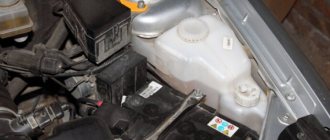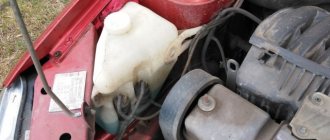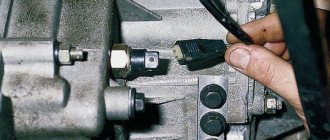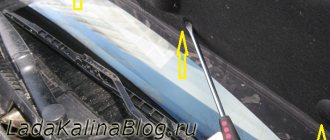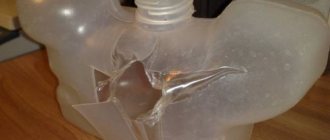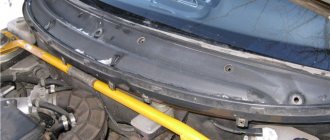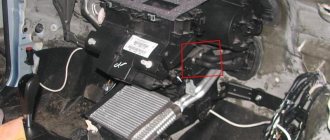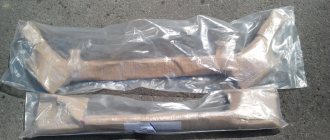What to do with your car in winter
Many motorists do not like winter due to the inconvenience of vehicle maintenance and operation. Motorcyclists understandably will wait for spring.
And drivers have to keep an eye on their “swallow”, promptly change the water in the windshield washer reservoir to a non-freezing one, preferably odorless, but that was the case, once I sat down with someone in a Skoda Rapid, he turned on the windshield washer, chemical liquid poured onto the windshield with a very pungent smell that my eyes began to water. I told the driver to replace it with a regular GOST odorless one, he said that he would finish this one so that the money wouldn’t be wasted.
Key points of the transition from summer to winter:
- replace rubber with studded or Velcro;
- assess the condition of the battery; if it is old and weak, then it is better to put it in a warm place at night, otherwise by the morning it will be almost dead;
- get used to driving style during icy conditions.
Why does the fluid in the washer reservoir freeze?
With the first frost, it is not enough to simply drain the water from the tank; you must thoroughly rinse the entire system. If you immediately fill the “anti-freeze”, it will not help to instantly melt the ice plugs that have formed. The pump motor, supply lines and nozzles, spraying liquid onto the glass, may freeze.
Important to know: How to make anti-freeze in your washer yourself
The same effect will occur if the non-freezing liquid does not meet the declared characteristics, when the frost is too severe or the amount of water in the composition exceeds the minimum allowable percentage for a given temperature.
Most often, drivers simply forget that there is water in the washer. The massive use of antifreeze in engines has led to the fact that the zero temperature threshold has ceased to play a role in the operation of cars. The error is detected only when the glass, translucent from dirt, needs to be cleaned.
Methods for defrosting a car washer reservoir
There are several ways to defrost frozen water in the windshield washer barrel. How long it takes for all the ice in the tank to melt depends on the outside temperature and the method.
Defrosting with hot water
Defrosting ice with hot water is effective if the container is half full or less. Although the plastic of the washer reservoir is quite durable, it is still forbidden to pour boiling water into the reservoir, otherwise the plastic will deform or crack.
Defrosting with a hot air stream using a hairdryer
A convenient way to warm up a frozen tank and hoses is to use an electric hair dryer. The main thing is that you need an extension cord and a hair dryer.
Operating procedure:
- Turn on the hairdryer, but not at maximum power. So that the air is warm, otherwise the hot air will destroy the frozen tubes and deform the tank.
- Heat the tank evenly from different sides. When the ice melts, you can pump out the water with a rubber bulb with a long tube.
- After melting the ice and draining the liquid, pour in clean non-freezing liquid. A good anti-freeze can withstand temperatures of -40.
- Check how the glass washer system works.
Alcohol or other antifreeze liquid
The method of adding alcohol liquid is also effective:
- Heat the alcohol to approximately +30 degrees.
- Pour warm alcohol into the tank.
- We pump out the melted water with a syringe or bulb.
- Fill with clean anti-freeze liquid.
If there is no anti-freeze, you can add vodka. But this method is suitable if there is less than a third of the ice in the tank, otherwise the vodka will melt some of the ice, mix with this water, the concentration will decrease and will not be able to melt further.
Melt the ice in the tank by warming up the internal combustion engine
You can warm up the tank by running the motor. But this method is not so effective and fast.
Operating procedure:
- Drive the car into the garage, open the gate and door to ventilate the garage.
- Cover the engine with an engine and radiator blanket.
- Turn the ignition key and start the engine. Wait until the internal combustion engine warms up to operating temperature. When the fan turns on, the circulation in the system will begin to accelerate.
- Turn off the engine. Wait 10 minutes. Open the tank and take a look. Drain the water.
- Fill with clean antifreeze.
Warming up the engine may not completely melt the ice in the system. Ice usually remains in the ventilation frill. It is advisable to warm it up with a hairdryer.
The engine melts it in a couple of hours. It is even more effective to use different methods together. For example, warming up the engine and adding warm alcohol to the tank.
Is the washer reservoir frozen? Warm up immediately!
Poor-quality anti-freeze or ordinary water, which did not resist the frost and naturally turned into ice, can return back to a liquid state with the arrival of a thaw. To force defrosting, you need to find heat.
Heat the whole car
The easiest way is to warm up the entire car. How can this be organized? There are three options:
- Drive the car into a warm parking lot, for example, in the basement of a shopping center.
- Warm up in a warm box.
- Visit a car wash and reserve a full package of services. External and internal washing with finishing work in the form of polishing plastic panels and applying wax to the body takes a lot of time, which may be enough to defrost the windshield washer.
The main disadvantage of complex heating is the large amount of time spent on defrosting. It will take about a day for the water to thaw if the car is placed in an underground parking lot. Things are more cheerful when I grabbed a demi-season anti-freeze, but still...
Heat the tank only
An excellent alternative to complex heating is defrosting only the washer tank. A failsafe option: remove the tank and take it home under a stream of lukewarm, and then hot water. The ice will quickly turn into liquid and the container can be emptied. Just don’t direct a hot jet at a cold part - it will crack instantly.
Advanced method: pour in some liquid and put a 12V boiler in the tank. It is important that the ice in the tank is not up to the neck. Otherwise, you won’t be able to add water, which means there will be nothing for the boiler to heat. That is why the filling volume of the tank is limited to between 1/2 and 3/4. We presented all the arguments for such a restriction in last year’s article about how much windshield washer fluid to pour into a car.
With the advent of powerful construction hair dryers, it became possible to heat the tank together with the pipelines. The method is good, but requires extreme caution and the presence of a 220 V outlet near the car.
Method 4
If the car is stored in a garage and the frozen washer reservoir was discovered before the start of the trip, you can warm it up with a hair dryer. However, when turning on the device, you should not direct a stream of warm air directly at the machine. There is a risk of damage to the paintwork due to local temperature changes.
It is also necessary to cover the engine compartment with greenhouse film and point the hair dryer at the garage floor under the front of the car. The air reflected from the concrete floor will rise upward and uniformly heat all the technical components of the car.
There will be no quick effect; you will have to wait at least half an hour until the liquid defrosts.
Why can't I use tap water instead of washer fluid? More details
How to avoid liquid freezing?
As mentioned above, prevention is always safer and simpler than radical rescue measures. To prevent windshield washer fluid from freezing in the reservoir and the rest of the system, you should:
- drain the water in a timely manner and replace it with anti-freeze before the onset of severe cold, with mandatory pumping through the lines, pump and nozzles;
- pour only concentrated frost-resistant anti-freeze with a low crystallization temperature into the washer reservoir (take into account the average air temperatures on your face in your region and carefully read the manufacturers' recommendations on the labels);
- refuse to dilute the antifreeze with the onset of frost;
- minimize the time the car is outdoors in severe frosts (either garage or use hood coverings);
- install heating on the windshield washer system (it is installed standard on almost any car model).
Removing the tank
On some cars, for example, on many VAZ models, up to Granta, this takes several minutes. And it will take the same amount of time to warm up the tank at home under hot water. On cars built on the B0 platform, the tank is located in a niche under the right side of the windshield. It is also better to remove it, although it involves a little more disassembly.
In most modern cars, for layout reasons, the tank is located in a cavity near the junction of the front bumper with the fender. You can't take it off quickly. This means we use other defrosting methods.
On Kalina, the washer reservoir can be removed in a couple of minutes.
On Kalina, the washer reservoir can be removed in a couple of minutes.
On the Nissan Almera, as well as on other models on the B0 platform, a little more effort is required - before disconnecting the wires and hoses and unscrewing the fastening bolt, you need to remove the plastic trim.
On the Nissan Almera, as well as on other models on the B0 platform, a little more effort is required - before disconnecting the wires and hoses and unscrewing the fastening bolt, you need to remove the plastic trim.
Automotive windshield cleaning system
For high-quality cleaning of glass, in addition to the so-called “wipers”, the mechanism for their fastening and movement, a functioning washing system with liquid detergent is required.
The image below shows a schematic diagram of the windshield washer device in principle. The location of the washer reservoir and the hoses connecting it to the nozzles may be different depending on the make of the car, but this does not change the essence. In any case, the tank is always placed away from the engine so that excessive heating does not cause deformation of the plastic housing.
The washer motor is installed in the reservoir, which pushes the cleaning agent to the nozzles.
This information is enough to understand what can freeze in this kit: the liquid component in the container, in the motor, in the hoses and nozzles. Defrosting must be complete. If the liquid has already thawed, but the system does not work, then ice still remains in other parts of it.
Snowball game. What to do if the windshield washer freezes?
The sudden onset of frost took many car enthusiasts by surprise, including journalists from our editorial office. The not-so-low-temperature washers that were filled in at the beginning of winter froze in the tanks, hoses and nozzles. Stopping near every snowdrift for a handful of snow for the windshield is never an option! How to defrost a windshield washer?
Method No. 1. From personal experience
In my case, the problem was solved by a long trip around the city and filling with low-temperature washer fluid. I was lucky most likely because the old fluid in the tank was almost gone, and the new one simply “melted” the remnants of the old one.
However, to find a liquid that freezes at temperatures below -20°C, I had to visit two supermarkets and three gas stations. All crushed! At one of the gas stations there was no anti-freeze liquid at all, and only at the last gas station was it possible to steal the last container of Krugozor from the display case with a temperature threshold below -25°C. Why weren’t shopping centers and gas stations prepared for the booming demand for washer fluids? Were you expecting global warming? Didn't wait...
In general, the method is clear. If there was little old fluid in the washer reservoir, simply pour in new fluid, but with a low freezing point. You can try to find a “wash” for harsh winters or pour in the most frost-resistant concentrate. But personally, I didn’t find anything below -25°C in five retail outlets.
What should I put in the washer reservoir? Our author Sergei Boyarskikh recently tested anti-freeze liquids - “Testing “anti-freeze”: which will freeze, which will not?
Method No. 2. “Pour vodka into the tanks, otherwise we won’t leave!”
Remember “Peculiarities of National Fishing”, where the heroes poured vodka into the tanks of the submarine? The principle is approximately the same: pour alcohol or vodka into the system - they will defrost the water in the tank. But there will be such a smell from the alcohol in the washer that if the traffic police stops you, then, quite possibly, the inspector will offer to take an alcohol test.
It is clear that it is morally difficult for our person to do this. But it is necessary, Fedya, it is necessary!
Method No. 3. “Sleep” in a warm room
It’s a pity you can’t, like in the cartoon about Prostokvashino, drag a car into an ordinary apartment. And if such a number will still work with the Peel P50, then with the Hyundai Accent, alas, it won’t.
The method is as follows: you need to leave the car in a heated garage or warm parking lot. To warm up the engine compartment, let the engine idle, which will speed up the process of defrosting the system. In the morning you just need to drain the old fluid and add new one.
By the way, if the reservoir is located near the engine, you can try to fill it with the same washer fluid for harsh winters and drive the car for a long time. But if it is located somewhere near the front bumper, then driving and warming up the car is useless.
Although it is still better to warm up the car well: the heat in the engine compartment will help to thaw the hoses of the windshield washer system.
Finding warm parking, it turns out, is also a problem. At an outside temperature of -18°C in the underground parking of the Skala shopping center near the metro station. “Sports” the on-board computer showed -10°C. This is unlikely to be enough to defrost the washer. But it’s warm in the Stolitsa shopping center. The prices here are quite affordable: holding a car for 2 hours costs 35,000, 3 hours - 40,000 rubles. For each subsequent hour, plus 3,000 accrues, and a day in the parking lot will cost 103,000 rubles.
Method number 4. Radical
The method seems to be the simplest: remove the tank and put it in a heated garage overnight or bring it home. This is if the tank is located in an easily accessible place, but often to dismantle it you need to remove some parts like the fender liner or bumper, which is labor-intensive and uncomfortable in the cold. But if they took it off, good. You can speed up the process by placing the tank on the battery or rinsing it with hot water, but not boiling water.
If the pipes and injectors are frozen and you have a garage, warm up the system with a hairdryer.
By the way, if the system itself is frozen and there is no hairdryer, you can disconnect the washer hoses and inject a special liquid into them to defrost the locks. Or the same alcohol. It is important that the engine is warmed up at this point - in a warm engine compartment, the supply tubes will quickly warm up and the ice in them will melt. When the washer starts working, do not spare the system - not only in the tank, but also in the pump, tubes, and nozzles there should be not water, but non-freezing liquid.
Another simple life hack - the nozzles can be cleaned and adjusted with a simple needle. Always keep it in the glove compartment or behind your visor.
How to drain old fluid from the washer fluid reservoir?
So, you have finally defrosted the washer fluid in the reservoir. Now it must be drained, and it does not matter at all what kind of substance it was previously - simple water or a special liquid. It will have to be replaced in any case, now it is imperative to use an “anti-freeze” one. How can I drain this liquid without removing the reservoir? We find the connection point of the hoses in the tank - you can carefully warm the connection point with a lighter - and disconnect it. We insert one end of the hose that comes out of the tank into a regular plastic bottle, start the engine and turn on the washer - all the liquid will flow into the bottle. Now feel free to fill in the “anti-freeze”. One note: if your car has headlight washers, make sure the headlights are turned off.
The liquid can also be drained using a piece of hose through the top, causing the necessary vacuum in it. The main thing is not to get poisoned by this crap.
If there is not much liquid, then we simply turn on the heater motor and wait until the liquid pours onto the glass.
Method No. 5. Hot water
If you didn’t have much liquid in the tank, you can fill it with hot water (not to the brim) and wait until the ice melts. Drain the old fluid and add a good anti-freeze solution. But the method is controversial. Firstly, you cannot pour boiling water, since a large temperature difference can cause the tank to become deformed. Secondly, if the old liquid does not melt, then we get several more liters of ice in the washer... If the liquid in the reservoir has melted, but nothing is still pouring onto the glass, then you need to pour hot water over the washer system tubes.
Method number 6. Combined
All previous methods can be combined at your discretion. But here is one of the interesting and quick solutions.
We go to the store and buy a high-quality “anti-freeze” that has the lowest possible temperature threshold. Next, we warm up the car to the maximum and heat the “anti-freeze” in any convenient way. When both the car and the anti-freeze system have warmed up sufficiently, add the heated liquid to the tank and drive to a warm room. Place the container with non-freezing liquid in a warm place where the air flow from the stove is directed. Upon arrival at your destination, take a container of liquid and add it to the tank, where space has become free due to the melting of ice (as you know, ice takes up more volume than water).
While the car is in a warm room and the defrosting process is in progress, you can go shopping and make the necessary purchases. After about two to four hours, depending on the amount of ice in the tank, the entire system should defrost, the pipes and nozzles should melt. After this, you need to drain all the water from the windshield washer reservoir and fill it with the liquid that was in the car.
Method No. 7. Boiler
You can try to melt the tank using a boiler. But a number of problems arise. The boiler must be very compact so that it fits into the filler neck. The tank can be damaged, you need a 220 volt power supply, etc. and so on. - in general, a dreary matter.
That's all for us. We tested how these methods work in practice back in 2007. Read about this in Ivan Kriskevich’s material “Three approaches to defrosting.”
Yuri GLADCHUK Photos by the author and from open sources ABW.BY
What tips can you give for defrosting the windshield washer? Leave your messages on the forum
How to tell if windshield washer fluid is frozen
Windshield washer fluid can freeze in severe frost in several cases:
- the windshield washer system was not completely drained of water before adding anti-freeze;
- you poured in a low-quality anti-freeze agent not intended for severe frosts or a highly diluted anti-freeze agent;
It is important to understand that frozen windshield washer fluid can destroy the entire system: the reservoir, injectors, rubber lines and washer pump. Therefore, you need to do everything to prevent this from happening, and if the liquid does freeze, quickly determine the causes of freezing and defrost the anti-freeze before it causes damage to the windshield washer system.
First, make sure that the liquid you pour into the washer reservoir is designed for very low temperatures (including extreme cooling when the car is moving). But, if the car has been standing in 30-degree frost for more than 10 hours, the probability of the anti-freeze device freezing is high.
It’s easy to check: unscrew the tank cap and make sure there is ice inside. To make sure that the liquid has frozen in the entire windshield washer system, start the car for 10-15 minutes until the engine warms up all systems (+70+80°C), then turn on the windshield washer - the liquid should almost instantly spray from the nozzles onto the glass. If this does not happen, continue to warm up the machine for another 10 minutes and try again. If the liquid does not flow again, it means that it has frozen throughout the entire system, including the pump.
FAQ
What do you put in the washer reservoir to defrost?
Provided that there is room in the reservoir for adding liquid, it is better to fill it with winter washer concentrate (“anti-freeze”). For better effect, you can preheat the liquid in a separate container or in a canister on the engine. Any alcohol-containing liquids are also suitable - but the less alcohol there is, the weaker the effect. Boiling water also helps, but it needs to be quickly drained from the tank, otherwise it can only worsen the situation.
Is it possible to pour boiling water into the washer reservoir?
In most cases, you can use boiling water to quickly defrost the liquid in the washer reservoir, except for old domestic cars, in which the plastic of the reservoir may crack due to temperature changes. Since in modern cars it is made of more durable materials, pouring boiling water will not cause damage to it. In an effort to quickly defrost the ice in the car washer reservoir, remember that as it melts, the temperature of the liquid decreases, and if it is not drained, the water will freeze again.
How to defrost windshield washer tubes?
The tubes can be warmed with a hairdryer or hot water (but not boiling water). They usually defrost on their own from the heat of the engine. There is very little water in the pipes and nozzles, and when the engine compartment warms up, the entire washer line will thaw on its own. But if the tubes are in a hard-to-reach place and there is ice left in them, then only heating in a warm room will help.
